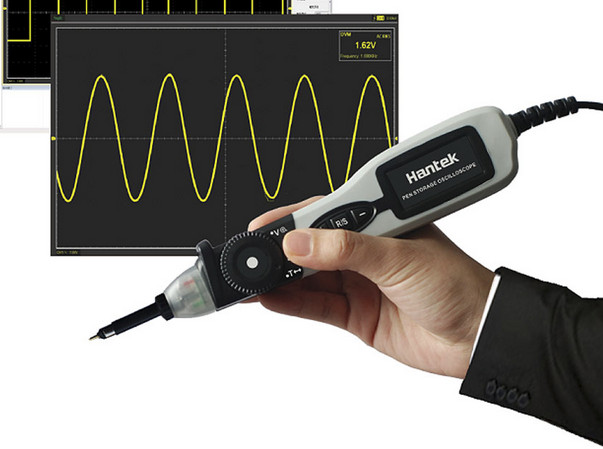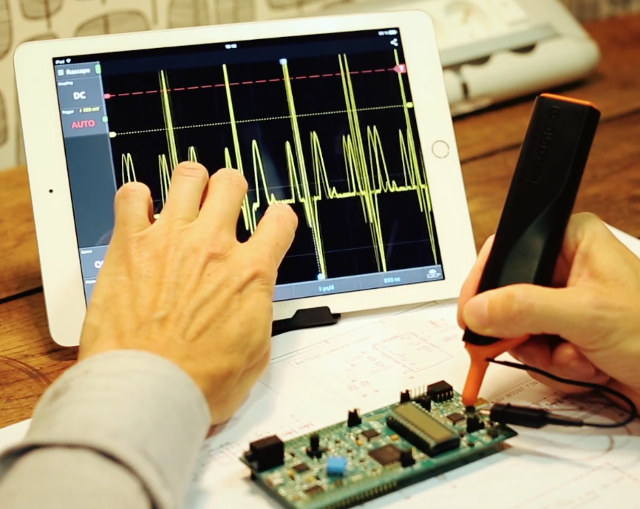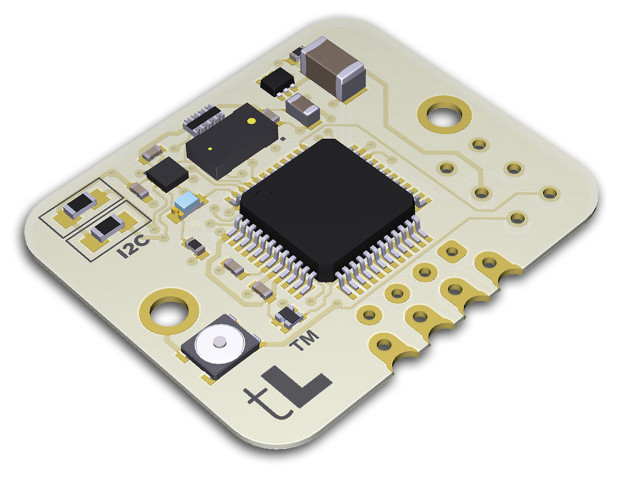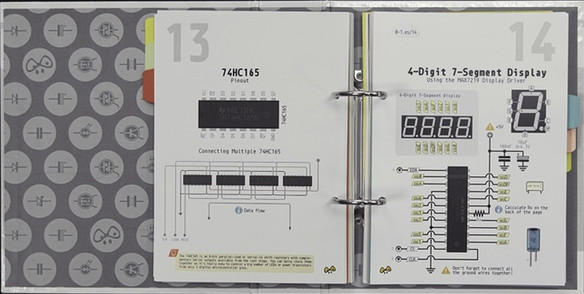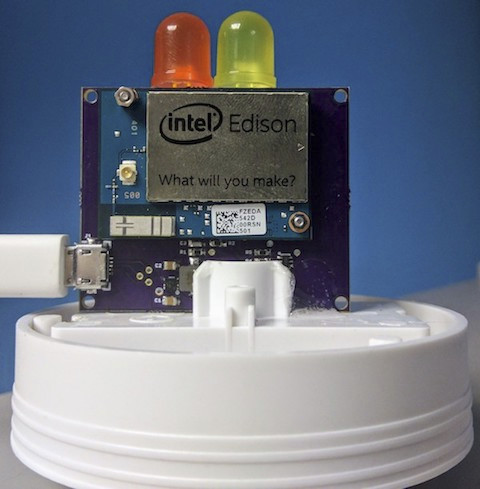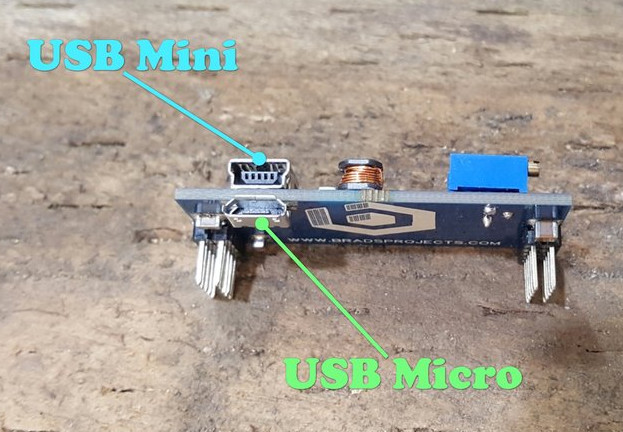I previously covered IkaScope & Aeroscope oscilloscope probes that are both portable and connect wirelessly to your mobile device or computer over respectively WiFi or Bluetooth. The former has slightly better specifications and sells for 300 Euros, while the latter goes for $200 US with 20 MHz bandwidth and 100 MSps capabilities. Several people mentioned it was more expensive than they were prepare to pay, but I’ve been informed about another portable solution: Hantek PSO2020 oscilloscope pen with about the same key specifications as Aeroscope 100A, except it relies on a USB port instead of a wireless connection. This also means it does not need a battery, and sells for much less at $53.20 including shipping. Hantek PSO2020 specifications: Analog Bandwidth – 20 MHz Sample Rate – 96 MSps Host Interface – USB 2.0 port Input Range – +/-50 V range Input Sensitivity – 20mV/div to 50V/div Offset Range – […]
IkaScope WiFi Oscilloscope Probe Works with Windows, Linux, Mac OS X, Android and iOS
Last year, I wrote about Aeroscope, a portable Bluetooth oscilloscope that looks somewhat like a Stabilo Boss highlighter pen, and sends measurements over the air directly to your Android and iOS tablet or smartphone. It was introduced through a crowdfunding campaign which eventually failed, but Aeroscope can now be purchased for $199 on Amazon US or their own website. If you’d prefer WiFi over Bluetooth, and would like something that also works on Windows, Linux, and/or Mac OS X, IKALOGIC has just launched IkaScope WiFi oscilloscope probe compatible with all popular mobile and desktop operating systems. IkaScope WS200 specifications: Analog Bandwidth – 30 MHz @ -3dB Sample Rate – 200 MSps Connectivity – 802.11 b/g/n/e/i WiFi @ 2.4 GHz configurable as access point or station Input Range – +/-40 V range CAT1 Offset Range – +/- 20V to +/- 40V offset Input Impedance – 10MΩ || 14pF Input Contact – […]
HTTM Backlit Capacitive Touch Switch / Button Sells for about one Dollar
You may have some project that requires buttons to turn on and off devices, or perform other tasks like navigating a user interface or playing games. One interesting and inexpensive solution for this could be HTTM (HelTec Touch Model) capacitive touch buttons that include three pins for power, ground, and the button status, as well as a backlight. You’ll find them on many websites, and one of the cheapest option is a pack of 10 buttons going for $9.91 on Aliexpress. HTTM button specifications: Voltage input range: + 2.7v to + 6v Signal output – Voltage: + 3.3v; Current up to 500 mA Header – 3-pin with GND, VCC, and OUT Backlight color – red, blue (cyan), or yellow Dimensions – 20.4 x 16.6 mm Operating temperature range: -30 ℃ to + 70 ℃ You’ll find more details on the manufacturer’s product page including a user manual (Chinese only), and […]
TinyLIDAR is a $15 LIDAR MCU Board based on STMicro VL53L0X Time-of-Flight Ranging Sensor (Crowdfunding)
LIDAR (Light Detection and Ranging) technology is used in autonomous car, drones, and some smartphones, in order to get an object position just like RADAR systems, but instead of using radio frequencies, it relies on infrared signals. High speed, long range LIDAR systems can cost several hundred dollars, but if you’d like to experiment with the technology, or your project would work just fine with 60 Hz scanning and a 2 meter range, tinyLIDAR could be a fun board to play with using Arduino compatible boards. TinyLIDAR specifications and features: LIDAR Sensor ST VL53L0X Time-of-Flight (ToF) ranging sensor 940nm laser VCSEL Up to 2 meters range Up to 60 Hz sampling rate even with Arduino UNO board Up to 3% accuracy with mm precision MCU – Unnamed dedicated 32-bit MCU (likely STM32) used to abstract the ST PAL API into simple I2C commands Host Interface – 4-pin I2C header; re-configurable […]
HT-01 “Helping Hand” Soldering Stand Comes with 6 Arms, a USB powered Fan
I have a “helping hand” in my office with two flexible arms and alligator clamps, and a magnifier that I use sometimes to solder or unsolder components more easily. The metallic arm are not always easy to put in the right position, and the base is not always heavy enough, but it does the job most of the time. But I’ve just come across with a helping hand station with 6 flexible gooseneck arms that may allow for more positions and easier setup, as well as hold a USB powered fan to such out fumes or blow them away, and/or a lamp. HT-01 soldering station features: Aluminum alloy base – 140 x 100 x 12mm (purple or black) 6x universal joint pipe of 300mm length with alligator clip 1 5V USB output regulator plate with two USB ports up to 5V/3A to connect fans 1x 5V USB Fan 1x Soldering […]
ABC: Basic Connections is a Book Listing Common Circuit Diagrams for Arduino Boards (Crowdfunding)
PighiXXX is known for their very useful and pretty pinout diagrams, but they’ve now created a book called “ABC: Basic Connections” comprised of a collection of easy to read circuit diagrams that shows you how to connect various circuits to your Arduino compatible board. The book is in file folder format, so you can easily remove the sheets you need during your project. While you can normally find pretty much whatever circuits you need on the Internet, ABC book’s diagrams looks very neat, and since it comes with 100 A5 pages of circuit diagrams such as LEDs, decoders, shift registers, 7-segment displays, mux/demux, light bulbs, DC motors, solenoids, relays and so on, you may discover circuits you did not know you needed. Every page of the book also comes with a 0-1.es/xx short URL redirecting to an online tutorial for the circuit with information about the theory, component list, tips, […]
Visualizing Electronics Manufacturing Price Variation with Volume and Lead Time
Google Android Things developers announced a production hardware sample based on Intel Edison module: Android Things is focused on helping developers build production ready devices that they can bring to market. This means building custom hardware in addition to the app software running on the Android Things system-on-module (SoM). As a part of this effort we have released Edison Candle, the first in a series of production samples designed to showcase hardware and software designed to work together. The code is hosted on GitHub and the hardware design files are on CircuitHub. That’s what the Edison Candle looks like. It’s just demo hardware to show how to build a product with a system-on-module (Intel Edison) for Android Things with everything released in Github. You can also purchase the board on CircuitHub, but then I saw the price was around $356 for such a simple board (without Edison). That’s quite a […]
Toaster Breadboard Power Supply Supports 3.3V, 5V, and Variable 5V to 16 V Outputs
YwRobot MB102 is a popular power supply for breadboards delivering 5V or 3.3V to both power rails. Bradsprojects’ Toaster power supply offers similar functionalities but beside outputting just 5V or 3.3V, it also adds a 5V to 16V variable output, and takes 5V from its micro or mini USB port.Toaster board specifications: Input Voltage – 5V via USB Mini and USB Micro port Input Current (max) – 1Amp Output Voltage 1 – 3.3 Volts Output Voltage 2 – 5 Volts Output Voltage 3 – Variable 5 Volts to 16 Volts with potentiometer Protection – 1.1Amp Resettable Fuse Output Connection – Standard Dual Rail Breadboard 2.54mm spacing. Dimensions – 50mm x 25mm You just need a screwdriver and a multimeter to adjust the variable output to your requirement.The Toaster board can be purchased on Tindie for $10 + shipping. Jean-Luc Aufranc (CNXSoft)Jean-Luc started CNX Software in 2010 as a part-time endeavor, […]


